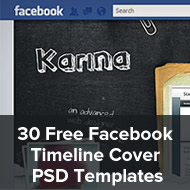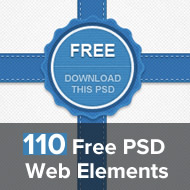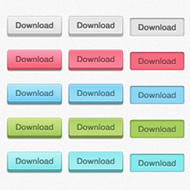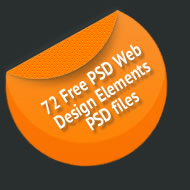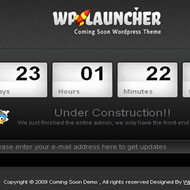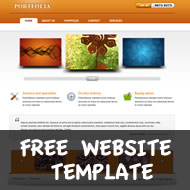26 Free eBooks for web designers to download
New free web design eBooks have been released and as you will see within this post, there are also a few free eBooks, recommended by our readers. If someone spends so much valuable time writing an entire specialized book and then offer it for free, in our eyes they deserve only praise and appreciation.
All of the 26 books in this post are completely FREE and can be either downloaded in digital format (PDF) or viewed as a web page (HTML).
1. Introduction to Good Usability by Peter Pixel
This guide is especially handy if you haven’t done a lot of webdesign yet or if you are involved in webdesign but don’t do any of the real work. I hope to shed some light on some common interface elements and mistakes people often make with them. A lot of books have been written in the past but the threshold for reading them, especially if you have never built a site, is quite big, hence this short guide. This is by no means a complete guide or solid set of rules, but it is definitely a good start.
Introduction to Good Usability
PDF
2. Web Accessibility Checklist by Aaron Cannon
Written by Aaron Cannon, blind web developer and accessibility consultant.Aaron explains in his article “The Accessibility Checklist I Vowed I’d Never Write”, that the problems with a “simple checklist that, when followed, will give you an accessible site without fail.” No such checklist exists or likely ever will. He believes that this list is not the perfect solution, nor is it the only solution, but believes it is a good first step, and it gives our developers and designers a place to start from.
Web Accessibility Checklist
PDF
3. CSS Systems For Writing Maintainable CSS by Natalie Downe
A CSS System is a reusable set of content-oriented markup patterns and associated CSS created to express a site’s individual design. It is the end result of a process that emphasizes up-front planning, loose coupling between CSS and markup, pre-empting browser bugs and overall robustness. It also incorporates a shared vocabulary for developers to communicate the intent of the code.
This ebook elaborates on this concept, and also describes a number of tricks used to preempt maintainability issues.
CSS Systems For Writing Maintainable CSS
PDF
4. Better CSS Font Stacks by Nathan Ford
One aspect of designing for the web that almost immediately offends designers is the lack of fonts that are considered safe to use. While it is true that there are only a handful of web safe fonts, the ones we do have at our disposal can be quite powerful and diversely useful. On top of that, CSS gives us a nice little thing called a font stack.
Better CSS Font Stacks
PDF
5. Faster, and More Secure Webfonts by Bram Pitoyo
Font embedding for the web is a great step in making the web look better and become more functional, but what about security and load times? Bram Pitoyo’s ebook takes the top layer off font embedding and shows us how things work, and ultimately how to improve performance and make it more secure.
Faster, and More Secure Webfonts
PDF
6. Designing for the Web by Mark Boulton
A Practical Guide to Designing for the Web aims to teach you techniques for designing your website using the principles of graphic design. Featuring five sections, each covering a core aspect of graphic design: Getting Started, Research, Typography, Colour, and Layout. Learn solid graphic design theory that you can simply apply to your designs, making the difference from a good design to a great one.
Designing for the Web
HTML Version
7. Taking Your Talent to the Web by Jeffrey Zeldman
This book was originally written in 2001 for print designers whose clients want websites, print art directors who’d like to move into full–time web and interaction design, homepage creators who are ready to turn pro, and professionals who seek to deepen their web skills and understanding.
The dot-com crash killed this book. Now it lives again. While browser references and modem speeds may reek of 2001, much of the advice about transitioning to the web still holds true.
Taking Your Talent to the Web
PDF
8. Dive Into HTML 5 by Mark Pilgrim
Dive Into HTML 5 is an ongoing book that seeks to elaborate on a hand-picked Selection of features from the HTML5 specification and other fine Standards. The final manuscript will be eventually published on paper by O’Reilly, under the Google Press imprint.
Dive Into HTML 5
HTML Version
9. jQuery Fundamentals
The purpose of this book is to provide an overview of the jQuery JavaScript library; when you’re done with the book, you should be able to complete basic tasks using jQuery, and have a solid basis from which to continue your learning. This book was designed as material to be used in a classroom setting, but you may find it useful for individual study.
jQuery Fundamentals
HTML Version
10. Design Your Imagination
Design Your Imagination is a one stop resource for the beginners and learners of website design. Though this e-book is mainly targeted for the beginners of website design, it might prove helpful for the experienced web designers as well. This free web design e-book is clearly divided into 28 chapters and in each chapter a specific topic is illustrated with ample examples. The language is as lucid as possible and proper care has been taken to keep intact the flow of writing.
Design Your Imagination
PDF
11. The Web Book
The Web Book contains all the information you need to create a Web site from scratch. It covers everything from registering a domain name and renting some hosting space, to creating your first HTML page, to building full online database applications with PHP and MySQL. It also tells you how to market and promote your site, and how to make money from it.
The Web Book
PDF
12. Building Accessible Websites
As this site is a repository for the text of a book published at a certain historical moment, this is not the place to correct or update the book based on knowledge or facts that did not exist at the time I wrote it. You may view the advice to use tables for layout, and a few other things, as artifacts of a sort.
Building Accessible Websites
HTML Version
13. The Elements of Typographic Style Applied to the Web (HTML)
For too long typographic style and its accompanying attention to detail have been overlooked by website designers, particularly in body copy. In years gone by this could have been put down to the technology, but now the web has caught up. The advent of much improved browsers, text rendering and high resolution screens, combine to negate technology as an excuse.
In order to allay some of the myths surrounding typography on the web, this website/book has been structured to step through Bringhurst’s working principles, explaining how to accomplish each using techniques available in HTML and CSS. The future is considered with coverage of CSS3, and practicality is ever present with workarounds, alternatives and compromises for less able browsers.
The Elements of Typographic Style (Full HTML)
Chapters
14. Integrating Accessibility Throughout Design (HTML)
The Web is providing unprecedented access to information and interaction for people with disabilities. It provides opportunities to participate in society in ways otherwise not available. With accessible websites, people with disabilities can do ordinary things: children can learn, teenagers can flirt, adults can make a living, seniors can read about their grandchildren, and so on.
With the Web, people with disabilities can do more things themselves, without having to rely on others. People who are blind can read the newspaper (through screen readers that read aloud text from the computer), and so can people with cognitive disabilities who have trouble processing written information. People who are deaf can get up-to-the-minute news that was previously available only to those who could hear radio or TV, and so can people who are blind and deaf (through dynamic Braille displays). Web accessibility is about removing those barriers so that people with disabilities can use and contribute to the Web.
This book helps you improve your products—websites, software, hardware, and consumer products—to remove accessibility barriers and avoid adding new barriers. One guiding principle is: just ask people with disabilities.
Integrating Accessibility Throughout Design: HTML version
Table of Contents
15. Getting Real: The Book by 37signals (HTML)
Want to build a successful web app? Then it’s time to Get Real. Getting Real is a smaller, faster, better way to build software.
Getting Real delivers better results because it forces you to deal with the actual problems you’re trying to solve instead of your ideas about those problems. It forces you to deal with reality.
Getting Real foregoes functional specs and other transitory documentation in favor of building real screens. A functional spec is make-believe, an illusion of agreement, while an actual web page is reality. That’s what your customers are going to see and use. That’s what matters. Getting Real gets you there faster. And that means you’re making software decisions based on the real thing instead of abstract notions.
Finally, Getting Real is an approach ideally suited to web-based software. The old school model of shipping software in a box and then waiting a year or two to deliver an update is fading away. Unlike installed software, web apps can constantly evolve on a day-to-day basis. Getting Real leverages this advantage for all its worth.
Getting Real: HTML Version
Chapters
16. Access by Design Online (HTML)
We design Web sites so people can use them. People doesn’t mean "some people" or "certain people." With universal usability, our goal is to design Web sites that accommodate the diversity of people and the Web browsing devices that they use. To design Web sites that people can use, we must work within the flexible framework that the Web provides.
To this end, we must begin our process with a solid understanding of how the Web works. When we know its nature, we can make intelligent design decisions that uphold rather than impede its functionality. Whenever we face a decision that may impact function, we must look for other options.
Access by Design Online: HTML Version
Table of Contents
17. Research-Based Web Design & Usability Guidelines (PDF)
The Research-Based Web Design & Usability Guidelines (Guidelines) were developed by the U.S. Department of Health and Human Services (HHS), in partnership with the U.S. General Services Administration.
The Guidelines were developed to assist those involved in the creation of Web sites to base their decisions on the most current and best available evidence. The Guidelines are particularly relevant to the design of information-oriented sites, but can be applied across the wide spectrum of Web sites.
Research-Based Web Design & Usability Guidelines(PDF)
18. Dive Into Accessibility (HTML & PDF)
This book is entitled “Dive Into Accessibility: 30 days to a more accessible web site”, and it will answer two questions. The first question is “Why should I make my web site more accessible?” If you do not have a web site, this book is not for you. The second question is “How can I make my web site more accessible?” If you are not convinced by the first answer, you will not be interested in the second.
To answer the second question,the book presents 25 tips that you can immediately apply to your own web site to make it more accessible. Although these concepts apply to all web sites, the focus is on implementation using popular weblogging tools. If you use some other publishing tool or template system, you will need to determine how to implement the tips in your tool of choice.
HTML VersionPDF Version
Chapters
19. Web Style Guide: Basic Design Principles for Creating Web Sites – 3rd Edition (HTML)
Written by Patrick J. Lynch and Sarah Horton for web site designers in corporations, government, nonprofit organizations, and academic institutions, the book explains established design principles and covers all aspects of web design—from planning to production to maintenance. The guide also shows how these principles apply in web design projects whose primary concerns are information design, interface design, and efficient search and navigation.
Web Style Guide 3rd Edition: HTML Version
Chapters
20. The Woork Handbook (PDF)
The Woork Handbook is a free eBook about CSS, HTML, Ajax, web programming, Mootools, Scriptaculous and other topics about web design.
This book is a miscellanea of articles written by Antonio Lupetti on his web design blogr. During the period form January to December 2008 “Woork” has been visited from over 4 millions visitors and has received a lot of requests to distribute a printable version of its contents.
The Woork Handbook: PDF Version
21. Web Designers Success Guide (PDF)
Web Designer’s Success Guide is the definitive guide to starting your own freelance Web design business. In this book, Kevin Airgid gives designers a step-by-step instructions on how to achieve the following: Transition from full-time to self-employment, Freelance on the side to make additional income, Find new clients and keep them coming back for more, Market your freelance business, Manage your projects professionally and how to Price your services appropriately.
Web Designers Success Guide: PDF Version
22. HTML5 Quick Learning Guide by freehtml5templates.com
This guide introduces you to just the main elements of HTML5 that you’ll probably want to use right away. This guide is for those who want to get the basics figured out first, and worry about the finer details later on.
HTML5 Quick Learning Guide
PDF
23. Web Font User Guide by FontShop
This Web FontFont User Guide contains information aimed at web developers, system administrators and website visitors.
Section B is for web developers, showing how to get started using Web FontFonts for display on your website. Section C contains information for system administrators about which configuration changes may be necessary to successfully serve webfonts from your web server and, finally, section D outlines some issues visitors of your website may experience in connection to webfonts and may assist site owners in answering webfont-related support requests.
Web Font User Guide
PDF
24. Why design? by AIGA
The "Why design?" booklet outlines the role of design in business strategy. It seeks a common framework for why design adds value to clients’ interests. It defines the power of Designing, a larger concept that includes strategy as well as artifacts across a variety of disciplines.
Why design?
PDF
25. The Design Funnel: A Manifesto for Meaningful Design by Stephen Hay
From the authour of this manifesto, Stephen Hay: “Would you like a process which would help translate the often vague, unclear wishes of your clients (and yourself, for that matter) into a clear and solid basis for your design? This manifesto will show you how.”
The Design Funnel: A Manifesto for Meaningful Design
PDF
26. How To Be Creative by Hugh MacLeod
Written by HughMacLeod, an advertising executive and popular blogger with a flair for the creative. He offers his 26 tried-and-true tips for being truly creative with each point being illustrated by a cartoon drawn by the author himself.
How To Be Creative
PDF




























